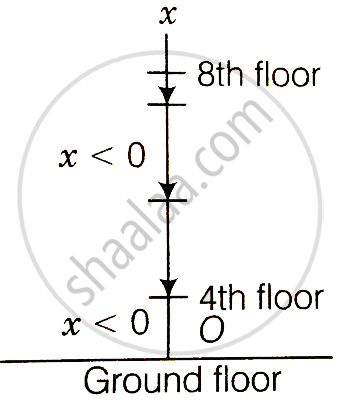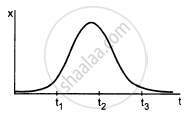Advertisements
Advertisements
Question
A lift is coming from 8th floor and is just about to reach 4th floor. Taking ground floor as origin and positive direction upwards for all quantities, which one of the following is correct?
Options
x < 0, v < 0, a > 0
x > 0, v < 0, a < 0
x > 0, v < 0, a > 0
x > 0, v > 0, a < 0
Solution
x < 0, v < 0, a > 0
Explanation:
As the lift is coming in a downward direction displacement will be negative. We have to see whether the motion is accelerating or retarding.
We know that due to downward motion displacement will be negative. When the lift reaches the 4th floor is about to stop hence, motion is retarding in nature hence, x < 0. a > 0.
As displacement is in negative direction, velocity will also be negative i.e., v < 0.
This can be shown on the adjacent graph.

APPEARS IN
RELATED QUESTIONS
Read the statement below carefully and state, with reason and example, if it is true or false:
A particle in one-dimensional motion with constant speed must have zero acceleration.
Suggest a suitable physical situation for the following graph:

The given figure gives a speed-time graph of a particle in motion along a constant direction. Three equal intervals of time are shown. In which interval is the average acceleration greatest in magnitude? In which interval is the average speed greatest? Choosing the positive direction as the constant direction of motion, give the signs of v and a in the three intervals. What are the accelerations at the points A, B, C and D?

If a particle is accelerating, it is either speeding up or speeding down. Do you agree with this statement?
Give example where the velocity of a particle is zero but its acceleration is not zero.
Give example where the velocity is opposite in direction to the acceleration.
In figure shows the x coordinate of a particle as a function of time. Find the sings of vx and ax at t = t1, t = t2 and t = t3.

The accelerations of a particle as seen from two frames S1 and S2 have equal magnitude 4 m/s2.
The displacement of particle is given by x = `2/lambda (1 - e^(-lambdat))`, the acceleration of particle at 2s when λ = 2s–1 will be (Take `l`n 0.018 = – 4)
Give example of a motion where x > 0, v < 0, a > 0 at a particular instant.
